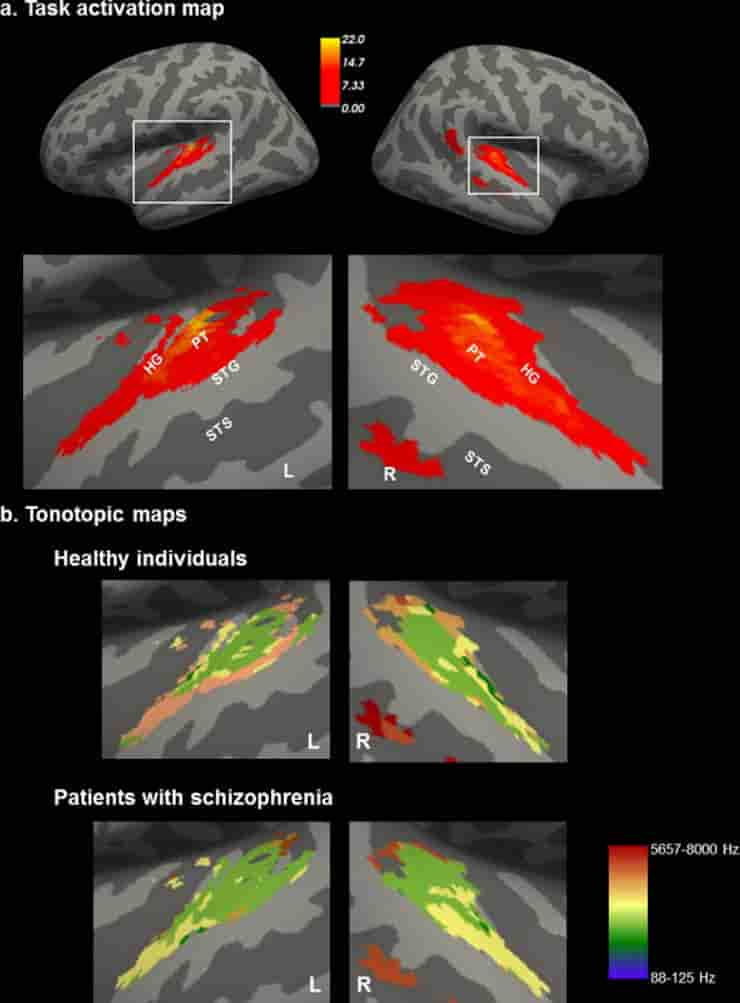To investigate the biological origins of hearing “voices” in patients with schizophrenia, a team led by researchers at the Icahn School of Medicine at Mount Sinai used ultra-high field imaging to compare the auditory cortex of schizophrenic patients with healthy individuals. They found that schizophrenic patients who experienced auditory hallucinations had abnormal tonotopic organization of the auditory cortex.
Tonotopy is the ordered representation of sound frequency in the auditory cortex, which is established in utero and infancy and which does not rely on higher-order cognitive operations. The study findings suggest that the vulnerability to develop “voices” is probably established many years before symptoms begin.
“Since auditory hallucinations feel like real voices, we wanted to test whether patients with such experiences have abnormalities in the auditory cortex, which is the part of the brain that processes real sounds from the external environment,”
says Sophia Frangou, MD, Ph.D., Professor of Psychiatry at the Icahn School of Medicine at Mount Sinai.
Tonotopic Maps
The research team used an ultra-high field scanner with a powerful 7 Tesla magnet to obtain high-resolution magnetic resonance imaging of brain activity while study participants listened passively to tones across a range of very low to very high frequencies. In healthy brains, these sounds are processed in a very organized fashion; each frequency activates a specific part of the auditory cortex forming a tonotopic map.
The team obtained tonotopic maps from 16 patients with schizophrenia with a history of recurrent auditory hallucination and 22 healthy study participants. They found that patients showed greater activation in response to most sound frequencies.

a) Group activation map of all participants regardless of diagnosis. Inflated representations of the left and right hemisphere are shown on the left panel. Light and dark colors reflect gyri and sulci, respectively. The white squares outline the part of cortex highlighted in the right panel. Color bar represents the degree of activation (T score)
b) Group tonotopic maps of healthy individuals and patients with schizophrenia. Each voxel is color-coded according to its maximum response to one of the seven frequency conditions. Color bar shows the range of frequency conditions. HG: Heschl’s Gyrus; PT: Planum Temporale; STG: superior temporal gyrus; STS: superior temporal sulcus, L: Left; R: Right.
Credit: Gaelle E. Doucet, et al. CC-BY
Additionally, the mapping of most sound frequencies to parts of the auditory cortex appeared “scrambled” in patients with schizophrenia, suggesting that the normal processes for the organized representation of sound in the brain are disrupted in schizophrenia.
“Because the tonotopic map is established when people are still infants and remains stable throughout life, our study findings suggest that the vulnerability to develop “voices” is linked a deviance in the organization of the auditory system that occurs during infancy and precedes speech development and the onset of psychotic symptoms by many years. This is particularly exciting because it means that it might be possible to identify potential vulnerable individuals, such as the offspring of schizophrenia patients, very early on,”
Frangou explains.
According to the authors, in addition to helping doctors spot people who are likely to experience hallucinations before the symptoms appear or become severe, the auditory cortex may be an area of consideration for novel neurmodulation methods to help patients who already have symptoms.
Current theoretical accounts of auditory hallucinations implicate both top-down and bottom-up mechanisms.
Looking ahead, Dr. Frangou’s research team will replicate and expand the current observations in larger samples to determine their relevance to hallucinations across diagnoses and to quantify the association of tonotopic disruption to auditory cortical activation and connectivity during actual hallucinatory experiences.
Reference:
- Gaelle E. Doucet, Maxwell J. Luber, Priti Balchandani, Iris E. Sommer & Sophia Frangou. Abnormal auditory tonotopy in patients with schizophrenia. npj Schizophrenia volume 5, Article number: 16 (2019)
Last Updated on November 14, 2023